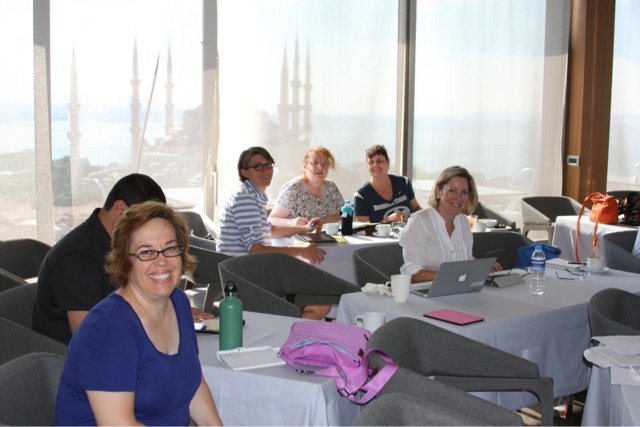Then we had a lecture from Kahraman Shakul of Istanbul Sehir University. He did his doctoral work at Georgetown. He is one of the new specialists in Ottoman military history and has been one of the influential scholars in helping change the interpretation of the military and janissaries. I was better able to understand how this system changed from taking the young Christian boys using the devshirme system (slavery of taking strong and bright boys to groom them for military or scholarly/technical purposes and converting them to Islam) to how the Janissaries became part of society and the system changed. It basically caused the authorities to use mercenaries after that, which caused a cycle of warring, then peace, then discontent, plundering and war again.
Dana then gave us a talk in preparation for tomorrow's experience in a very conservative section of Istanbul. She talked about the different communities of the cities and how they were at first ethnically divided until structures were put in place which caused the elites especially to mix more in villages along the Bosphorus. It was really interesting. I am looking forward to tomorrow.
Lunch and the rest of the day was on our own, so I elected to take a break in my room with what we have purchased at a little market, and enjoy my break. Then a group of us decided to go to the military museum up in the Taksim area (yes, the area of protests). We took a bus and had no problems. The museum was really neat, albeit not interpreted, just displays of items, except for the Armenian exhibit, which was shocking to see the difference in perspective. See photos with explanations below.
We took this photo this morning on break on our roof with Hagia Sophia in the background. Fellow BYU alumni. Stacey is going to post this on the Facebook page showing alumni in different places in the world. She is a planner, I tell you. She thought to bring a t-shirt. Stacey is a brilliant artist, one of the funniest new friends I now have, and a great addition to my wonderful time here in Turkey. She lives close to Disney World too, so that may have to be another trip sometime. What do you think, kids?
The military museum is full of dioramas which tell stories (though briefly, because it is mostly full of objects) of mighty conquests of the early Turks and the empire later.
This was the form of warfare that made a moveable fortress basically. It was not always what made them successful however and is probably given more credit than necessary.
This place had more swords and weapons than I was really interested in, but I'm sure little boys and some big ones too would probably love it. :-)
The conquest moment diorama of 1453. This was clearly the gem of the museum. This diorama seemed almost life-size.
Another crazy part of this museum is that it is almost a shrine to Ataturk. Here he is pictured as a student. I sat to take a flirting picture with him, as he seems to be the pride of at least the more secular Turks today. Do I look enamored?
So the most disturbing part of the museum was the description of what is normally taught as the Armenian genocide. This museum focuses centrally on atrocities done by the Armenians to the Turks. This is partially why I am a history teacher--to try to help students understand multiple perspectives and portray them as accurately as possible, using a variety of sources and points of view. This exhibit is very contrary to that. It is both atrocious and sad. See the captions. That is really what I was focusing on.
After that depressing battle stuff we watched a performance of a Janissary band. This was fantastic! Western Europeans took several instruments and styles from the Ottomans here including symbols and drums. Today's military and marching bands with the batons and mace come from the Ottoman tradition. I loved this performance, which included singers and the instrumentals. There are some costumes just to show the military side. We had fun taking pictures with them as a group. I'm glad I took the extra trip. Interesting experience.
These drummers have a long metal-type stick in their left hand, which they used in addition to drumming with a regular stick in their right. I have not seen this before. You percussionists out there may know what this is. It was really cool to watch them.
Loving the flowers here. It is hard to see the scale of these hydrangeas, but they are double the size of almost any others I have seen.
One of the giant cannons the Ottomans were famous for. Brian is in my study group. He hails from Topeka, Kansas.

































No comments:
Post a Comment